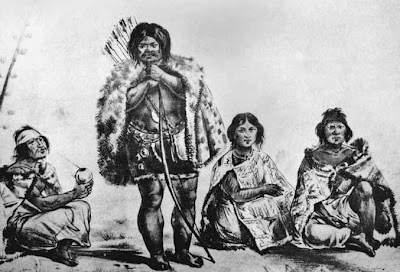In the expansive prairies that presently make up the eastern and southern provinces of Argentina, small bands of hunter-gatherers predominated. They hunted native animals such as deer, guanacos, armadillos, prairie dogs, and South American ostriches. In the woodlands of Patagonia, gathering seeds and hunting deer formed the basis of existence. The coastal peoples of Patagonia hunted seals and fished from canoes. For many centuries, life was much the same for these peoples. They too lived in small bands, celebrated their independence, and confounded the first Europeans.
Just before the Europeans arrived, the larger cultural and linguistic groups of the Querandí, Puelche, and Tehuelche inhabited large sections of the Argentine Pampas and Patagonia. These peoples moved mainly on foot and set up camps based on the seasons and hunting opportunities. They were little encumbered by material goods. Their tools were simple, usually bone and stone weapons and scrapers, products of their Stone Age existence. The peoples of the Argentine prairies, however, would become known for one unique weapon: the bolas. Made of three round stones covered by animal skin and connected by leather cords, the bolas, flung by a skilled hunter, could bring down guanacos, ostriches, and other large game. The hunter whirled the bolas around his head and flung them at the legs of his prey. He then moved in on the hobbled animal to make the kill with a spear or club.
The principal bands of the Pampas and Patagonia were quite small, made up only of a few families or clans. In this sense they were like other southern hunters. There existed no confederations of tribes or a rigid differentiation of their societies between warriors and hereditary leaders. Yet, these peoples did observe sharp gender differentiation, with women subordinated to men, who for the most part were monogamous. Women cleaned game, cooked, cared for and disciplined the children, put up the toldos, wove baskets, and made simple pottery. Men and women alike shared duties of gathering and preparing food and may have discussed basic decisions within families before the men met in council. As warriors and hunters, the men dominated the formal decision-making processes and carried out raids on neighboring groups.
Just before the Europeans arrived, the larger cultural and linguistic groups of the Querandí, Puelche, and Tehuelche inhabited large sections of the Argentine Pampas and Patagonia. These peoples moved mainly on foot and set up camps based on the seasons and hunting opportunities. They were little encumbered by material goods. Their tools were simple, usually bone and stone weapons and scrapers, products of their Stone Age existence. The peoples of the Argentine prairies, however, would become known for one unique weapon: the bolas. Made of three round stones covered by animal skin and connected by leather cords, the bolas, flung by a skilled hunter, could bring down guanacos, ostriches, and other large game. The hunter whirled the bolas around his head and flung them at the legs of his prey. He then moved in on the hobbled animal to make the kill with a spear or club.
The principal bands of the Pampas and Patagonia were quite small, made up only of a few families or clans. In this sense they were like other southern hunters. There existed no confederations of tribes or a rigid differentiation of their societies between warriors and hereditary leaders. Yet, these peoples did observe sharp gender differentiation, with women subordinated to men, who for the most part were monogamous. Women cleaned game, cooked, cared for and disciplined the children, put up the toldos, wove baskets, and made simple pottery. Men and women alike shared duties of gathering and preparing food and may have discussed basic decisions within families before the men met in council. As warriors and hunters, the men dominated the formal decision-making processes and carried out raids on neighboring groups.



